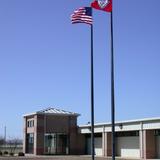- Coahoma offers a broad array of programs in the academic, vocational and technical areas, as well as many other opportunities to serve your educational and training needs. Since its inception in 1949, CCC boasts of a highly - qualified faculty that is committed to superior educational standards and dedicated service to our community.
School Highlights
Coahoma Community College serves 2,534 students (58% of students are full-time).
The college's student-teacher ratio of 11:1 is lower than the state community college average of 13:1.
Minority enrollment is 95% of the student body (majority Black), which is more than the state average of 51%.
Quick Facts (2025-26)
- Enrollment: 2,534 students
- In-state tuition: $2,240
- Out-state tuition: $3,240
- Student-teacher ratio: 11:1
- Minority enrollment: 95%
- Source: Integrated Postsecondary Education Data System (IPEDS)
Top Rankings
Coahoma Community College ranks among the top 20% of public schools in Mississippi for:
Category
Attribute
Affordability
School Resources
School Overview
The teacher population of 235 teachers has stayed relatively flat over five years.
Coahoma Community College
(MS) Community College Avg.
Carnegie Classification
Associate's Colleges: High Career & Technical-High Traditional
Associate's Colleges: Mixed Transfer/Career & Technical-High Traditional
Institution Level
At least 2 but less than 4 years
At least 2 but less than 4 years
Institution Control
Public
Public
Total Faculty
235 staff
371 staff
School Calendar
Student Body
The student population of Coahoma Community College has grown by 40% over five years.
The student-teacher ratio of 11:1 has increased from 7:1 over five years.
The Coahoma Community College diversity score of 0.19 is less than the state average of 0.60. The school's diversity has grown by 66% over five years.
Total Enrollment
2,534 students
3,944 students
Student-Teacher Ratio
11:1
13:1
# Full-Time Students
1,459 students
2,538 students
# Part-Time Students
1,075 students
1,406 students
# Enrollment Undergraduate
253 students
366 students
# Full-Time Undergraduate Students
1,459 students
2,538 students
# Part-Time Undergraduate Students
1,075 students
1,845 students
Total Dormitory Capacity
419 students
814 students
% American Indian/Alaskan
n/a
n/a
% Asian
n/a
1%
% Hispanic
n/a
3%
% Black
90%
39%
% White
5%
49%
% Hawaiian
n/a
n/a
% Two or more races
n/a
3%
% Non Resident races
n/a
n/a
% Unknown races
3%
5%
Diversity Score
0.19
0.60
College Completion Rate (Students who graduate in less than 4 years)
33%
39%
Average Graduate Earnings (10 Years)
$23,200
$30,000
Tuition and Acceptance Rate
The public in-state tuition of $2,240 is less than the state average of $2,427. The in-state tuition has declined by 25% over four years.
The public out-state tuition of $3,240 is less than the state average of $4,463. The out-state tuition has grown by 7% over four years.
In-State Tuition Fees
$2,240
$2,427
Out-State Tuition Fees
$3,240
$4,463
% Students Receiving Some Financial Aid
99%
91%
Median Debt for Graduates
n/a
$8,448
Median Debt for Dropouts
n/a
$4,808
Acceptance Rate
n/a
100%
Source: 2024 (or latest year available) Integrated Postsecondary Education Data System (IPEDS)
School Notes
- Coahoma offers a broad array of programs in the academic, vocational and technical areas, as well as many other opportunities to serve your educational and training needs. Since its inception in 1949, CCC boasts of a highly - qualified faculty that is committed to superior educational standards and dedicated service to our community. Life on the Coahoma Community College campus offers students an excellent academic program, opportunities for personal growth, and lasting friendships. Intramural sports are held for both men and women. The Career Development Center is an extensive facility offering students, faculty, staff, and area residents information on a wide range of career-related subjects. Resources available include career references books, materials from professional organizations, job search, resume and interview information. In addition to materials on most careers, the center maintains current information on colleges and universities from throughout the United States including lists of majors, transfer requirements, sources of financial aid and scholarships. The Career Development Center provides career planning and job search assistance throughout the year; assistance is also available in the selection of a college major. Coahoma Community College is accredited by the Commission on Colleges of the Southern Association of Colleges and Schools to award the associate degree.
Frequently Asked Questions
How much does Coahoma Community College cost?
Coahoma Community College's tuition is approximately $2,240 for In-State students and $3,240 for Out-State students.
What is Coahoma Community College's ranking?
Coahoma Community College ranks among the top 20% of community college in Mississippi for: Least expensive tuition, Average community college minority breakdown and Percent of students receiving financial aid.
Recent Articles

Scholarships for Community College Students 2025
Explore updated scholarship programs, tuition data, and expert strategies for community college students in 2025.

The Rise of Technical and Vocational Training in 2025
Explore the 2025 surge in technical and vocational training—enrollment, policy, costs, and why this path is gaining ground for students and parents.

Stackable Credentials: How Community Colleges Advance Careers
Discover how community colleges use stackable credentials to build career pathways, boost earnings, and enable lifelong learning in 2025.










